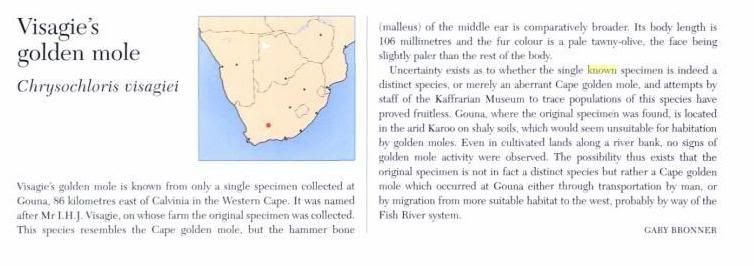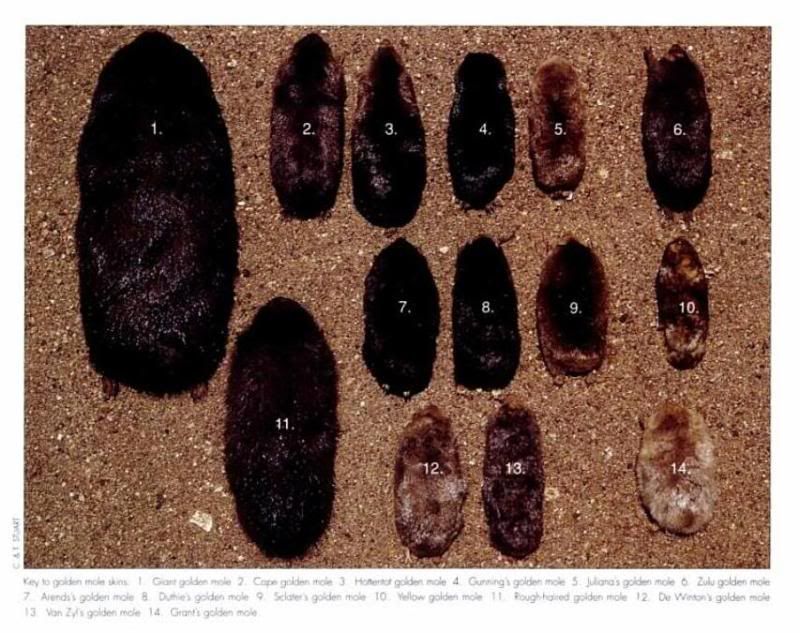|
|
Post by sebbe67 on Apr 22, 2005 7:43:40 GMT
Chrysochloris visagiei
Known from a single specimen collected 1949 from Gouna, Northern Cape Province, South Africa.
|
|
|
|
Post by another specialist on May 5, 2005 19:40:47 GMT
*** It is thought that the single specimen by which this species is known may in fact just be an aberrant form of the related Cape golden mole, Chrysochloris asiatica, and that Chrysochloris visagiei may not be a valid species.
Animal Info - Visagie's Golden Mole
(Other Name: Visagie's Cape Golden Mole)
Chrysochloris visagiei
Status: Critically Endangered
--------------------------------------------------------------------------------
Contents
1. Profile
2. Tidbits
3. Status and Trends (IUCN Status, Countries Where Currently Found, History of Distribution, Threats and Reasons for Decline)
4. Data on Biology and Ecology (Size & Weight, Habitat, Birth Rate, Diet, Behavior)
5. References
--------------------------------------------------------------------------------
Profile
Golden moles are an ancient group of mammals who live mostly below ground. They have shiny coats of dense fur and a streamlined, formless appearance. They have no visible eyes or ears; in fact, they are blind - the small eyes are covered with hairy skin. The ears are small and are hidden in the animal's fur.
The size of moles in this genus is 90 - 140 mm (3.5 - 5.5") and their weight is about 25 - 35 g (0.89 - 1.3 oz). Usually 2 young are born, sometimes 1. Golden moles eat invertebrates such as insects, earthworms and snails. Golden moles in the genus Chrysochloris are thought to capture most of their food underground. The young of golden moles are born in a grass-lined cavity in the ground. Golden moles usually dig tunnels just below the ground.
Visagie's golden mole is known only from a single specimen collected at Gouna, in Cape Province, South Africa. The limited habitat of Visagie's golden mole is declining.
--------------------------------------------------------------------------------
Tidbits
*** As long as it is awake, a golden mole keeps on the move. This exercise keeps its body temperature normal. If it stays still too long, its temperature falls quickly. Sleeping would be hazardous if it weren't for the fact that its muscles twitch while it is asleep. This produces heat to help stabilize its body temperature.
*** It is thought that the single specimen by which this species is known may in fact just be an aberrant form of the related Cape golden mole, Chrysochloris asiatica, and that Chrysochloris visagiei may not be a valid species.
--------------------------------------------------------------------------------
Status and Trends
IUCN Status:
1994: Indeterminate
1996 - 2004: Critically Endangered (Criteria: B1+2c) (IUCN 2004)
Countries Where Visagie's Golden Mole Is Currently Found:
2004: Occurs in South Africa (Cape Province) (IUCN 2004).
History of Distribution:
Visagie's golden mole is known only from a single specimen collected at Gouna, 87 km (54 mi) east of Calvinia, Cape Province, South Africa.
Threats and Reasons for Decline:
The limited habitat of Visagie's golden mole is declining.
--------------------------------------------------------------------------------
Data on Biology and Ecology
Size & Weight:
The size of moles in this genus is 90 - 140 mm (3.5 - 5.5") and their weight is about 25 - 35 g (0.89 - 1.3 oz).
Habitat:
Visagie's golden mole is one of the species that live in the Cape Floristic Region Biodiversity Hotspot (Cons. Intl.).
Birth Rate:
Usually 2 young are born, sometimes 1.
Diet:
Golden moles eat invertebrates such as insects (e.g. crickets, grasshoppers, locusts and cockroaches), earthworms and snails. Golden moles in this genus are thought to capture most of their food underground.
Behavior:
The young of golden moles are born in a grass-lined cavity in the ground.
Golden moles usually dig tunnels just below the ground.
|
|
|
|
Post by another specialist on May 22, 2006 7:22:22 GMT
|
|
|
|
Post by another specialist on May 22, 2006 7:23:20 GMT
Taxonomic Notes Subgenus Chrysochloris. Possibly an aberrant asiatica; see Meester (1974). Simonetta (1968:31) listed it as a subspecies of asiatica. This could be incertae sedis. Red List Category & Criteria DD ver 3.1 (2001) Year Assessed 2006 Assessor/s Bronner, G. (Afrotheria Specialist Group) Evaluator/s Rathbun, G. (Afrotheria Red List Authority) & Sechrest, W. (Global Mammal Assessment) Justification Agriculture has dramatically transformed habitat at the type locality, but impact thereof cannot be assessed given uncertainty about provenance of the type specimen and/or the habitat requirements of the species. No specimens have been seen or collected since its description, despite two expeditions to the type locality. Further research may show this species to qualify for CR. History 1988 - Insufficiently Known (IUCN Conservation Monitoring Centre 1988) 1990 - Indeterminate (IUCN 1990) 1994 - Indeterminate (Groombridge 1994) 1996 - Critically Endangered (Baillie and Groombridge 1996) Range This species is known from a single specimen collected from the type locality at Gouna, Northern Cape, South Africa. Several field trips to ground-truth the occurrence of this species have yielded no specimens, or even signs of golden moles, suggesting either an error in recording provenance, or that the original specimen was transported there by anthropogenic means or even perhaps floodwaters of the Renoster River, flowing from the Roggeveld mountains further south. Population No data as no signs of this species have been found at the type locality during two independent expeditions in the last 20 years. Habitat and Ecology The type locality is situated in Bushmanland Nama-Karoo, with extensive agriculture on the alluvial sand floodplains of the Vis and Renoster rivers. Adjacent natural habitats are gravel plains and small hills, which appear unsuitable habitats for chrysochlorids. Threats No data. Extensive agriculture has dramatically transformed habitat at the type locality, but impact thereof cannot be assessed given uncertainty about provenance of the type specimen and/or the habitat requirements of the species. Conservation Measures Research is needed to ground-truth the existence of this species in the Gouna area, and/or to trace the locality from which the type specimen was collected. Study of more specimens required to clarify systematics status. www.iucnredlist.org/search/details.php?species=4812&tab=all |
|
|
|
Post by sebbe67 on Aug 14, 2006 20:37:26 GMT
This project will also clarify the systematic and conservation status of Visagie s golden mole (Chrysochloris visagiei), known from only a holotype collected near Calvinia, which some authors consider to be only an aberrant C. asiatica. Further research is clearly needed to establish if this taxon does indeed occur in the Calvinia district, and to clarify its systematic before its true conservation status will become clear. www.scienceinafrica.co.za/Jobs/biol.htm |
|
|
|
Post by another specialist on Aug 15, 2006 5:30:47 GMT
|
|
|
|
Post by another specialist on Aug 15, 2006 5:34:46 GMT
UNIQUE OPPORTUNITIES TO STUDY THREATENED & ENDEMIC GOLDEN MOLES AT A WORLD-CLASS AFRICAN UNIVERSITY! 27-Jan-04 This project will also clarify the systematic and conservation status of Visagie s golden mole (Chrysochloris visagiei), known from only a holotype collected near Calvinia, which some authors consider to be only an aberrant C. asiatica. Further research is clearly needed to establish if this taxon does indeed occur in the Calvinia district, and to clarify its systematic before its true conservation status will become clear. Not sure if they have found anything new out of this study? www.africanconservation.org/dcforum/DCForumID7/198.html |
|
|
|
Post by another specialist on Jan 7, 2008 8:08:32 GMT
|
|
|
|
Post by another specialist on Jul 9, 2008 16:50:27 GMT
Chrysochloris (Chrysochloris) visagiei Author: Broom, 1950. Citation: Ann. Transvaal Mus., 21: 238. Common Name: Visagie’s Golden Mole Type Locality: South Africa, Western Cape Prov., Gouna (54 mi. [87 km] E Calvinia). Distribution: Known only from the holotype. Status: IUCN – Critically Endangered. Comments: Subgenus Chrysochloris. Possibly an aberrant asiatica; see Meester (1974). Simonetta (1968:31) listed it as a subspecies of asiatica. www.bucknell.edu/msw3/browse.asp?s=y&id=11100070 |
|
|
|
Post by another specialist on Oct 11, 2008 6:03:08 GMT
Taxonomy [top] Kingdom Phylum Class Order Family ANIMALIA CHORDATA MAMMALIA AFROSORICIDA CHRYSOCHLORIDAE Scientific Name: Chrysochloris visagiei Species Authority Infra-specific Authority: Broom, 1950 Common Name/s: English – Visagie's Golden Mole Assessment Information [top] Red List Category & Criteria: Data Deficient ver 3.1 Year Assessed: 2008 Assessor/s Bronner, G. Evaluator/s: Rathbun, G. (Afrotheria Red List Authority) & Hoffmann, M. (Global Mammal Assessment Team) Justification: Agriculture has dramatically transformed habitat at the type locality, but impact thereof cannot be assessed given uncertainty about provenance of the type specimen and/or the habitat requirements of the species. No specimens have been seen or collected since its description, despite two expeditions to the type locality. Further research may show this species to qualify for Critically Endangered. History: 2006 – Data Deficient (IUCN 2006) 1996 – Critically Endangered (Baillie and Groombridge 1996) 1994 – Indeterminate (Groombridge 1994) 1990 – Indeterminate (IUCN 1990) 1988 – Insufficiently Known (IUCN Conservation Monitoring Centre 1988) Geographic Range [top] Range Description: This species is known from a single specimen collected from the type locality at Gouna, Northern Cape, South Africa. Several field trips to ground-truth the occurrence of this species have yielded no specimens, or even signs of golden moles, suggesting either an error in recording provenance, or that the original specimen was transported there by anthropogenic means or even perhaps floodwaters of the Renoster River, flowing from the Roggeveld mountains further south. Countries: Native: South Africa Population [top] Population: No signs of this species have been found at the type locality during two independent expeditions in the last 20 years. Population Trend: Unknown Habitat and Ecology [top] Habitat and Ecology: The type locality is situated in Bushmanland Nama-Karoo, with extensive agriculture on the alluvial sand floodplains of the Vis and Renoster rivers. Adjacent natural habitats are gravel plains and small hills, which appear unsuitable habitats for chrysochlorids. Systems: Terrestrial Threats [top] Major Threat(s): Extensive agriculture has dramatically transformed habitat at the type locality, but impact thereof cannot be assessed given uncertainty about provenance of the type specimen and/or the habitat requirements of the species. Conservation Actions [top] Conservation Actions: Research is needed to ground-truth the existence of this species in the Gouna area, and/or to trace the locality from which the type specimen was collected. Study of more specimens required to clarify systematics status. www.iucnredlist.org/details/4812 |
|
|
|
Post by another specialist on Dec 6, 2008 6:47:44 GMT
 The Complete Book of Southern African Mammals By M. G. L. Mills, Lex Hes |
|
|
|
Post by another specialist on Dec 6, 2008 6:58:40 GMT
 The Complete Book of Southern African Mammals By M. G. L. Mills, Lex Hes |
|
|
|
Post by Sebbe on Aug 3, 2015 18:54:20 GMT
|
|